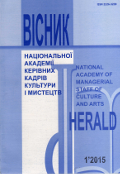РОЗТАШУВАННЯ ДІТЕЙ ХОРА У СЦЕНІ З 17-ї ГЛАВИ КНИГИ МЕРТВИХ У КОНТЕКСТІ СПАТІАЛЬНИХ ТА АНТРОПОГОНІЧНИХ УЯВЛЕНЬ СТАРОДАВНІХ ЄГИПТЯН (на матеріалі джерел Птолемеївського періоду)
Disposition of the children of Horus in the scene from chapter 17 of the Book of the dead in the context of the spatial and the anthropogonic believes of the ancient Egyptians (according to the Ptolemaic sources)
Author(s): Kristina MasalovaSubject(s): Customs / Folklore, Visual Arts, Semiology, Ethics / Practical Philosophy, Ancient World, Cultural Anthropology / Ethnology, History of Religion
Published by: Національна академія керівних кадрів культури і мистецтв
Keywords: the Book of the Dead; vignettes; Children of Horus; Ancient Egyptian mythology; Ptolemaic Period;
Summary/Abstract: The article is devoted to the scene from the number of vignettes-illustrations of the Book of the Dead in the last phase of its existence, the Ptolemaic Period. Some interesting features of the scene were distinguished, according to the previously made compositional and typological analysis. These features are linked with dispositions of the four gods, the Children of Horus, in the composition of the scene. The most general disposition of gods between each other was determined, what gave an opportunity to interpret this feature. Semantic interpretation was made according to the spatial and anthropogenic conceptions of ancient Egyptians, who connected the Children of Horus with cardinal points and with the limbs of a person.
Journal: Вісник Національної академії керівних кадрів культури і мистецтв
- Issue Year: 2015
- Issue No: 1
- Page Range: 73-78
- Page Count: 6
- Language: Ukrainian

